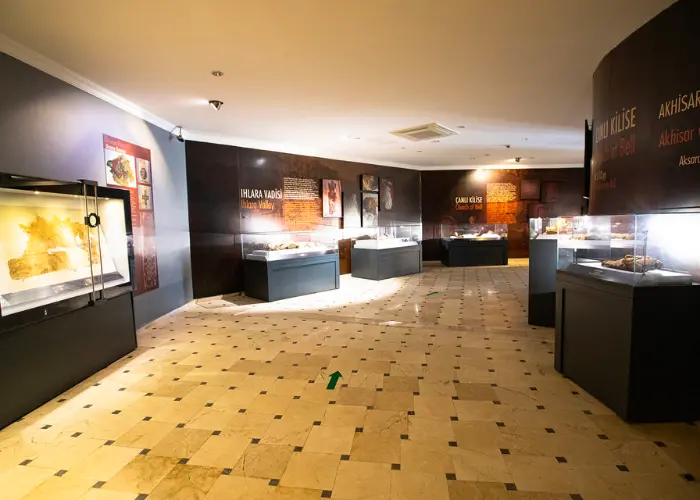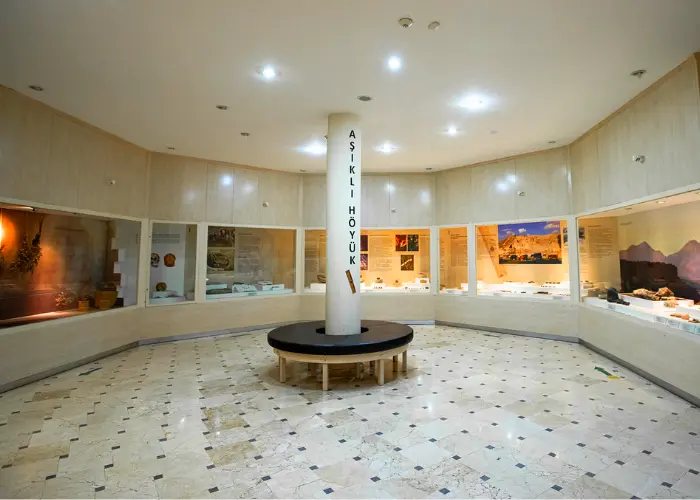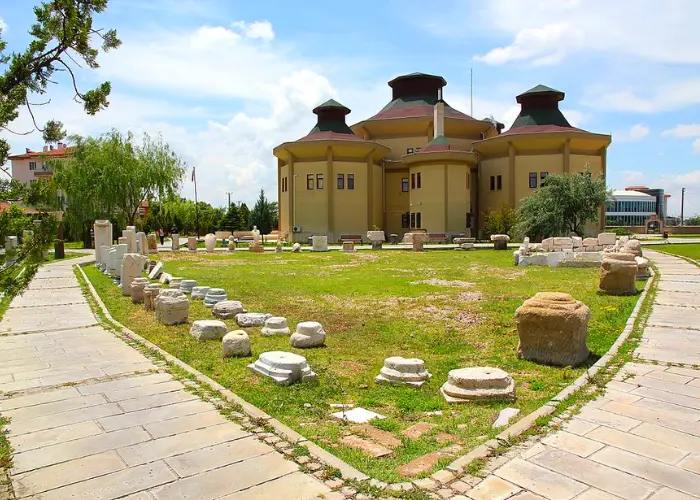Aksaray Museum Entrance
Museums
Walk-in
Aksaray Museum Entrance
Museums
Price Without Pass: Priceless
Free with Cappadocia Travel Pass®
Your digital pass includes:
Free access to 35+ top Attractions
All digital, Show&Go easy Access
Saving guarantee after purchase
Huge savings up to 70%
Starting from just €175
Cancel anytime!
Enjoy the Surprisingly Rich Collection
The Aksaray Museum features a variety of historical artifacts from many historical eras, including the Neolithic and Ottoman Empires. There are 16,093 pieces of artifacts in the museum, including ethnological and archeological ones. You can see the skull which is proof of one of the oldest brain operations in the world. There is also a hall of mummies. So, don't miss this amazing museum during your Cappadocia trip!
About The Aksaray Museum Entrance
Mobile ticketing - No need for a printed voucher, we're digital!
Duration - Unlimited Free time.
Instant confirmation - No reservation needed - instant confirmation
Highlights
Discover the rich archeological collection including mummies
Witness the first brain surgery in the world
Have a glimpse of the lives of inhabitants who lived in thousands of years
Includes
Entrance to Aksaray Museum
Details
The 1969-founded Aksaray Museum was renovated in 2014 and reopened to the public with a chronological exhibition sequence. The Aksaray Museum features a variety of historical artifacts from many historical eras, including the Neolithic and Ottoman Empires.
The remnant of a brain surgery found in a skull thought to have belonged to a woman between the ages of 20 and 25 is one of the important ancient artifacts discovered in Asikli Mound. An 11.5 mm-diameter hole found in the skull of the mother who had been buried next to her 9-month-old kid may be one of the earliest brain operations ever discovered. The bone tissue surrounding the hole showed signs of healing that persisted after the operation. The tissue with a width of 1-2 mm had begun to recover on its own, therefore the patient survived the procedure and continued to live for a few weeks.
Hours & Meeting
Open every day
Opening time: 09:00
Closing time: 16:30
How To Get There?
Hacılar Harmanı Mahallesi, Konya Caddesi No: 5, Bulvar No:16 Aksaray
All About Aksaray Museum Entrance
The face area of the Aksaray Museum is 12,000 square meters, with a closed space of 2,000 square meters. The museum contains 16,093 different artifacts.
Five halls are located on the ground floor of the museum structure, which has three floors and an octagonal layout. Five display spaces are interconnected by hallways, and an archaeological artifact storehouse is used for one study. The artifacts are kept in five warehouses on the third floor.
What is there to see?
The three major categories of artifacts are ethnographic, archaeological, and coinage. The collection of ethnographic artifacts comprises recent goods used on a daily basis as well as apparel and jewelry used on special occasions like holidays and weddings as well as weapons like swords and rifles used in battle. Weapons also include implements like scales and dirhams, which are significant in commerce. The archaeological artifact category includes a wide range of objects from the Neolithic, Chalcolithic, and Early Bronze Ages, which began around 8,500 B.C., as well as the Middle Bronze, Late Bronze, Iron, Hellenistic, Roman, and Late Roman Periods. Coins from gold, silver, and bronze mines that date back to the Ottoman Period, beginning in the Greek Period, make up the coin group.
Animal fossils and diverse soil and stone samples from the Aksaray Geological Periods are displayed in a showcase in the exhibition's first hall. In other showcases, artifacts unearthed as a result of scientific excavations carried out in the 10,500-year-old Neolithic Age Asiklihoyuk settlement, which is the oldest settlement of Aksaray and Central Anatolia, are exhibited. The item groupings include stone grinders and mortars, blades, knives, mirrors made of obsidian, pendants made of stone and bone, awls, fishing rods, and buckles made of bone. Additionally, the skull of a young woman is visible, demonstrating that Asiklihoyuk is the site of the world's oldest skull surgery (10,000 years ago). In two displays, there is also a visual exhibition that depicts Asiklihöyük's domestic and outside-the-home life.
Artifacts from the Middle Chalcolithic town of Pigeon Rock, which dates to a later period (5,500 BC), and Musular, a Neolithic settlement, are on display in the second exhibition hall. The Asiklihöyük works in general share the same traits as the Musular works. The samples of pots and pans, whose construction is unknown in Asiklihöyük, were discovered in Musular, which is the only distinction. Here you can view handcrafted clay January-footed pots, animal sculptures, sling stones, weights, Güvercinkaya stone mortars and pestles, bone awls and handles, and obsidian tools.
The exhibit of relics from Acemhöyük excavations that are still present in Yeşilova now is housed in the third exhibition hall. Acemhöyük is a significant example of the Early Bronze Age, which took place in Anatolia between 3000 and 2000 B.C., despite having reached its peak during the Middle Bronze Age. One of the key hubs of the Assyrian trading colonies that brought writing to Anatolia was the settlement of Acemhöyük.
The exhibit includes pithoi (large grain and liquid storage containers), burnt door fragments, water pipes, stone axes, terracotta pots and coasters, cups, glasses, pots, and sacred drinking vessels, as well as buttons and game stones, ingot silver pieces, bone handles, and terracotta bullas (seal impressions).
In addition to comparable ceramic pieces discovered in the Acemhöyük town, from the Arbaş Cemetery, one of Acemhöyük's graves, remains of painted pots and jugs with clover mouths from the Phrygian Period were also brought to the attention of tourists by animating the display case. Even though Acemhöyük's prominence declined after the Middle Bronze Age, the exhibition's last showcase contains further pot-and-pot-weighted objects from a tiny Iron Age settlement that existed nearby.
Works from the Iron Age, Hellenistic Age, Roman, Eastern Roman, and Seljuk Periods are displayed in showcases in the fourth exhibition hall. Terracotta pots, fibulae, cooking utensils, glass artifacts, an Asclepius statue, jewelry, and other items are displayed in these exhibits. In the same room are coins from the Greek, Roman, Eastern Roman, and Islamic eras together with silver and gold treasure group coins.
The Hall of Mummies
The hall of Mummies is how the fifth hall is set up. The infant and adult mummies discovered in the Ihlara Valley and the Canli Church near Aksaray, most of which are dated between the 10th and 13th centuries A.D., are displayed next to a cat's mummy. This exhibition hall features everyday objects discovered with the mummies, including beads, necklace beads, linen-woven embroidered clothes, jewelry from the Eastern Roman Period, oil lamps, and more.
A Mirror for the Lives of People
The craftsmanship of carpet making, basket making, pottery making, and stone processing, which are handicrafts manufactured in our region, was restored in the ethnography display on the second level. A calligrapher's pen holder, men's and women's clothing, a coffee roasting pan reflecting coffee culture, a cooling container, a coffee storage box, and a cup envelope can all be found in this hall. The hamam culture exhibition case includes hand embroidery towel sets and nalin in addition to embroidery samples such as uçkur, peshkir, hijab, and napkins in the hand embroidery display case. The faith culture presentation also features amulets, ointment bottles, and healing stones.
Dirhams, weighing scales, money changers' scales, and bench weights from the Ottoman and Republican periods are shown in the showcase where the weights are on display. A silver jug used for telling fortunes that dates to the 13th century is displayed in this hall's most recent display case. The 12 zodiac signs that make up the Zodiac cycle are depicted on this container along with prayers. A pithos area was constructed in 2016 despite the museum's garden landscaping still being done. A protected area for Islamic tombstones and inscriptions was constructed in 2018. For excavating supplies and mosaics, a storehouse was constructed.
Gallery
Advantages Of Cappadocia Travel Pass
Cappadocia Travel Pass comes with several benefits. Price reduction is one of the biggest benefits but surely not the only one! You can not only save a lot of money by purchasing a Cappadocia Travel Pass but also save a huge amount of precious time by skipping long queues with your pass. Feel like a VIP unlocking the doors of the top attractions and experiences in Cappadocia. Moreover, you can even fly over Cappadocia with a DISCOUNTED hot air balloon and get to experience the mysterious fairy chimneys from the sky!
Aksaray Museum Entrance Frequently Asked Questions
What is there to see in Aksaray Museum?
What are the working hours of the Aksaray Museum?
Museum is open every day between 9 AM - 4.30 PM.
Is it worth visiting Aksaray Museum?
Yes, especially if you love history! There are well-preserved mummies, archeological artifacts, amazing jewelry as a part of ethnological artifacts, and many more.
Other Popular Attractions

4.8 out of 5 stars
Cappadocia Travel Pass has an average rating of 4.8 /5 from 1075 reviews
Read all traveler reviews →










There are various archeological and ethnological artifacts in the Museum. The collection is so rich and well-preserved.